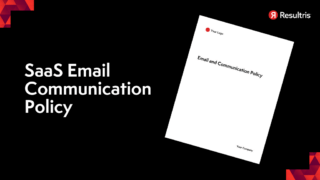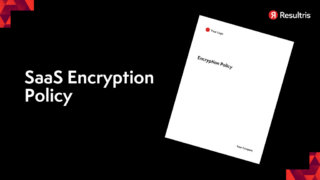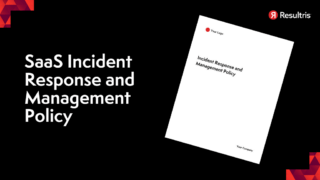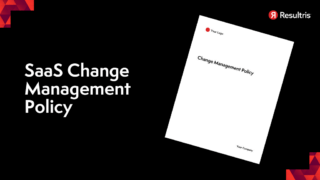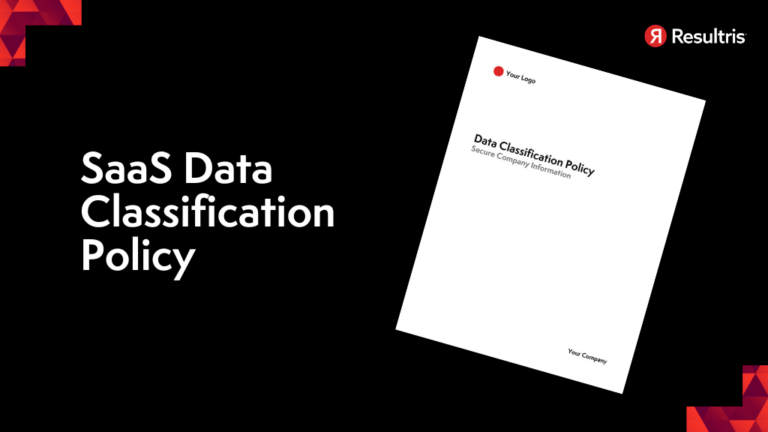
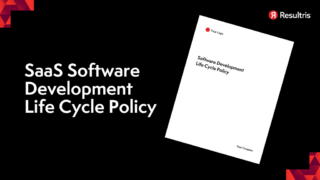
Written by: Tim Eisenhauer
Last updated:

As you navigate the complex world of Software as a Service (SaaS), understanding the importance of a robust SaaS Data Classification Policy becomes crucial.
This policy isn’t just about ticking off compliance boxes. It’s about safeguarding your business’s most valuable asset—information. It’s about understanding what data you have, where it’s stored, and how it’s protected. With a well-implemented data classification policy, you’re not just complying with regulations—you’re building a resilient business. This is another post in our series about SaaS Compliance and Security Best Practices.
So, let’s dive in and explore the intricacies of SaaS data classification. Let’s arm you with the knowledge you need to make informed decisions, ensuring your data remains secure in the cloud.
Drilling down into SaaS Data Classification throws light on the optimum strategies for data safety. It serves as the key to successfully securing the integrity of your information assets.
A SaaS Data Classification Policy categorizes data into different types, usually based on sensitivity and compliance requirements. This grading allows for effective application of protective measures. In essence, it’s much like organizing your own personal library.
In the cloud’s ever expanding universe, your SaaS data nobly stands, crucial to your business and vulnerable all at once. The purpose of a data classification policy lies in its ability to pinpoint sensitive information and facilitate a layered protection spectrum. This classification necessitates meticulous sorting of data making it easier for your team and regulatory bodies to handle. Information classification, hence, it’s pivotal in the crux of data security.
As a SaaS company, living by a data classification policy does pay off! Besides fortifying your data defense line, it also streamlines internal processes, fortifying the company’s face to the customer. Plus, a thorough understanding of SaaS data categories brings about heightened awareness of resource allocation, steering the company to better data management practices.
Chalked up next are regulatory demands that your business can’t afford to ignore.
Regulations such as GDPR and CCPA are dedicated to fortifying the privacy rights of individuals, dictating that data handlers comply with strict requisites. A robust data classification policy rubs off positively on your compliance score, painting your business in a compliant light.
To add to the list are industry-specific compliance standards. If you’re in healthcare, it’s HIPAA, in finance, it’s SOX, and the list goes on. A comprehensive cloud data classification roadmap helps your business align seamlessly with evolving compliance standards. Remember, this isn’t just about ‘checking the boxes’. Yourdataclassification policy equates to your commitment towards a secure digital framework, a tiny drop in the vast ocean of trust-building initiatives.
Initiating your journey into data classification requires certain key steps. Let’s explore them.
Before designing a data classification policy, you’ve to understand your SaaS data categories—what exists and where it’s stored.
Three principal types of data prevail in SaaS environments: user data (entered by users), event data (user interactions with the system), and metadata (descriptive about other data). Grasping these differences becomes crucial while dealing with privacy laws or custom requirements.
Mapping your data flow forms an intrinsic part of your SaaS policy. It allows you to trace the data origin, journey, and potential exit points, aiding in strong governance over your cloud data classification.
Data Classification addresses the essence of information classification. Defining your own classification levels adds precision to your data handling.
Public data refers to information freely accessible, no confidentiality restrictions. Examples include company websites, blogs, or newsletters.
This is the data intended solely for internal company use. Examples include internal emails, meeting notes, or project timelines.
Information under this level is reserved for restricted audiences within the company. Salary details, pre-release product information, or certain financial records are instances of confidential data.
Restricted data carries severe regulatory controls and non-compliance penalties. Records containing personally identifiable information (PII), credit card details, or health data fall into this category.
These are fundamental components that make up a sensitive data policy.
Labels or tags are essential for tracking data. Your policy must elaborate on how data at each classification level is labeled and stored.
Detail how data at different levels should be accessed, transmitted, or disposed of. For example, restricted data may require additional security measures.
Finally, your policy must clearly state who can access which types of data, and for what purpose. This includes access control systems, user monitoring, and authority delegation.
By following these strategic steps, you can yield a robust SaaS Data Classification Policy.
Acting upon your SaaS data classification policy necessitates a methodical approach. It’s not just about setting rules; it’s about adopting the right tools, training your team, and stitching the policy into the fabric of your operations. Let’s break down each component.
It’s critical to leverage technologies that facilitate data classification. Cloud data classification tools categorize your data based on determined rules, aiding in the enforcement of your data classification policy. These tools sift through SaaS data categories including user data, event data, and metadata. They tag and label data accurately, simplifying data management. For instance, Sensitive Data Discovery software helps detect sensitive data, conforming to your sensitive data policy. Another useful tool includes Data Loss Prevention (DLP) solutions that mitigate risks associated with data leakage.
Informed employees equate to your first line of defense. It’s vital to train your team members about the value of data, information classification methods, and crucially, your organization’s data classification policy. Enlighten them about data sensitivity, the implications attached, and how mismanaging data can lead to regulatory sanctions. More often than not, data breaches occur due to human error. By promoting a culture of data security awareness, you fortify your enterprise against avoidable mishaps.
Data classification mustn’t be an afterthought, relegated as an additional duty. For effective data protection, your SaaS data classification policy should be integrated into your everyday business processes. You may start with integrating the policy into your project plans, system designs, and partners’ contracts. By doing so, you gradually inculcate data protection in your organization’s DNA, thereby proliferating a robust culture of data privacy and security.
Let’s delve deeper into the importance of data governance and management in a robust SaaS Data Classification Policy. We’ll focus on the interactive roles of data owners and custodians, along with the crucial phases of data lifecycle management.
Data owners and custodians play a critical part in a successful SaaS data classification policy. Owners generally know the ins and outs of the data they oversee. They’re entrusted with maintaining its integrity. Custodians, by contrast, handle the everyday tasks of managing this information. They tackle data protection, deal with access control, and implement the sensitive data policy. Both actors need cooperation. They’re the equilibrium to a smoothly-operating data management system.
Effective cloud data classification must encompass every stage of the data lifecycle. That’s from creation and collection, to storage and access, to transmission and sharing, and finally, to retention and disposal. Let’s dive into these phases one by one.
The birth of data commences at this stage. You may collect it from various sources or perhaps, you create it internally. Remember, it’s essential at action one to apply the data classification policy to ensure all SaaS data categories are accurately categorised.
Once created or collected, data needs safe housing. This step involves determining access permissions, segregation and security of data. Access to this stored data should align with the provisions of your information classification system, providing a clear way to manage different types of data.
At some point, your data may need to move or be accessed by other parts of your organization. It’s in the transmission and sharing phase where rigorous governance is crucial, ensuring that data is shared securely without compromising on confidentiality.
Final but significantly important phases of the data lifecycle are retention and disposal. Data can’t sit indefinitely on your servers. It’s vital to map out a timeline for data retention and have a clear disposal plan. Remember to comply with organizational and legal requirements when concluding the lifecycle of a data entity.
This comprehensive approach to data lifecycle management fortifies your SaaS Data Classification Policy, ensuring your precious data remains protected at every stage and in every scenario.
Now that we’ve delved into data governance and lifecycle management, let’s dive into the security measures pivotal to a successful SaaS Data Classification Policy. This section focuses on three main areas: Access Controls and Authentication, Encryption Standards for Different Data Classes, and Monitoring and Auditing Classified Data.
Implementing robust access controls forms a cornerstone of any information classification policy. By defining which users have access to specific SaaS data categories, businesses minimize the risk of unauthorized access. With user authentication, a two-step verification process is often used. This way, on top of inputting a password, users get asked for another form of identification — they’ll provide biometric data, answer a security question, or use an authentication token. The additional layer of security slows down anyone attempting unauthorized access to sensitive data policy assets.
Not all data classes are created equal in the eyes of a SaaS data classification policy. The sensitivity of the data as well as its value to an organization inform the level of encryption necessary. For non-sensitive data, a lower-level encryption method suffices, often reducing costs and resource usage without compromising data integrity. On the other hand, encryption for sensitive and business-critical data tends to be high-level, employing advanced techniques and protocols to thwart any attempt at unauthorized access or tampering.
Last but not least is the practice of regular monitoring and auditing classified cloud data classification. It’s essential to continuously scrutinize the system for any aberrations or possible breaches, as these could indicate security threats. Auditing tools capture useful data such as user activity, changes in data access, usage patterns, and security events, aiding efforts in maintaining data integrity. With auditing processes in place, organizations can swiftly identify and rectify honest mistakes or malicious activities, thus ensuring regulatory compliance and data safety. Remember, it’s not just about setting up security measures, it’s about continually verifying their efficacy.
Despite the advantages of a thorough SaaS Data Classification Policy, it’s not without its hurdles. Let’s dive into these challenges and see how they can be addressed.
Unstructured data poses a significant challenge in data classification. Unlike structured and semi-structured data, unstructured data lacks a predefined format or organization, making it difficult to classify. It’s primarily textual, also incorporating multimedia elements such as images, audios, and videos.
Data classification tools can struggle to determine the relevance and importance of this data type. The enormity of unstructured data, prevalent in cloud environments, amplifies the challenge. Extracting sensitive information, one of the main goals of a data classification policy, can be a tough task.
Another hurdle is managing data in multi-tenant environments, where multiple users or organizations share the same cloud infrastructure. While cost-effective, this setup poses data separation challenges. Categorizing data correctly across different tenants, while ensuring each tenant’s data is secured and isolated, is crucial. This requires a robust SaaS data classification policy that can adequately separate and manage different data sets.
Maintaining a balance between security and usability is another stumbling block. Heightened security measures can impede data accessibility, affecting end-user experience and productivity. On the other hand, overemphasizing usability can compromise security, exposing sensitive data to unwanted risks.
Strikingly, a well-implemented data classification policy can strike this delicate balance. By classifying data based on sensitivity and importance, the policy can determine which data categories need higher security levels, ensuring users can access less sensitive data without obstacles.
Embarking on the journey of SaaS data classification isn’t just about defining a policy but also about implementing actionable and sustainable practices that ensure long-term data security and regulatory compliance. Let’s delve deeper into these practices.
Embrace automated techniques in your data classification policy to effectively handle vast SaaS data categories. Manual handling of such extensive data sets tends to be prone to oversights, making automation an efficient and reliable solution. Through Machine Learning algorithms, you can effectively classify unstructured data, enabling swift identification and protection of sensitive information. Automating the classifying process assures consistency and saves time by reducing manual labor involved.
Don’t consider your data classification policy as a static document, but a dynamic one, evolving along the turbulent tides of business needs, regulatory changes, and advancement in cloud architectures. Regular reviews and updates of your SaaS data classification policy keep it relevant in the changing landscape of data security. You’re not only expected to stay ahead of regulatory requirements but also to meet emerging security threats head-on.
Breaches in your information classification policy, unfortunately, could occur, emphasizing the need for a robust and swift incident response plan. Your plan should identify, contain, and manage data breaches, minimizing potential damage from the misuse of sensitive data. Also, it’s crucial to adhere to notification requirements, if any, where regulators and affected parties are informed within the prescribed timelines. In a nutshell, preparedness for possible incidents is just as important as preventive measures.
Just having a SaaS Data Classification Policy isn’t enough. Monitoring its effectiveness plays a crucial role as well.
When gauging the impact of your data classification policy, Key Performance Indicators offer concrete metrics. They polish your policy, keeping it effective and relevant. Common KPIs associated with data classification include Misclassification Rate, Time taken to Classify Data, and Number of Data Items Classified.
A Misclassification Rate tracks how often data is incorrectly tagged with an inappropriate classification level. For accurate results, keep this ratio as low as possible. It’s an indicative warning of your sensitive data policy’s performance. A high rate requires urgent attention for your cloud data classification strategy.
Time taken to Classify Data is another vital KPI. It measures the efficiency of the classification process. Reduction in this metric often showcases the effective implementation of automated classification techniques.
Thirdly, the Number of Data Items Classified enables you to understand the amount of data processed under the strategy. A consistent increase implies your SaaS data categories are expanding, signifying a robust and inclusive data classification policy.
In this ever-evolving technological world, continuous improvement is a non-negotiable aspect of any IT policy, including your data classification policy. Regular audits and analysis of KPIs help identify gaps in your existing strategy. However, it’s equally crucial to address these gaps proactively with relevant changes.
Implement a review mechanism that incorporates user feedback to boost the effectiveness of your policy. Stay updated with latest trends, such as incorporation of Machine Learning algorithms for classification. In case of unstructured SaaS data, focus on devising new methods to handle classification more firmly and accurately.
Moreover, when breaches occur, swiftly analyze incident response. It provides valuable insights for improvement. Remember, in the race to secure data, the journey is as essential as the destination. Thus, the inclusion of continuous improvement strategies truly completes the data classification policy.
In the realm of SaaS Data Classification Policy, it’s clear that exciting advancements lie ahead. Overcoming challenges and managing data effectively can be made easier with the adoption of upcoming trends. Here’s what the future holds.
AI and Machine Learning (ML) are increasingly becoming influential in shaping SaaS Data Classification Policies. Leveraging ML algorithms, organizations can classify vast amounts of unstructured data in the blink of an eye. While manual classification involves substantial time and resources, AI and ML capabilities automate the process, increasing efficiency and mitigating human errors. For example, sensitive data can be promptly identified, mitigating the risk of breaches while adhering to information classification guidelines.
“Never trust, always verify”, that’s the mantra of Zero Trust Data Security Models. As cloud data classification needs elastic security models, Zero Trust plays a pivotal role. In the context of SaaS data classification, Zero Trust means secure access to data irrespective of user location or the device used. It’s an active shift from perimeter-based security to a more decentralized approach. The adoption of Zero Trust models creates multiple layers of security, safeguarding your classified SaaS data from potential threats.
Edge computing has emerged as a valuable asset in dealing with latency issues inherent in data transmission, making real-time data processing a reality. In such environments, quickly classifying and processing data close to its origin is a must for optimal performance. This has a direct impact on your SaaS data classification policy, with edge computing requiring you to refine how you classify, store, and secure data. As more organizations incorporate edge computing into their operations, the significance of well-balanced, robust data classification policies will rise.
You’ve seen how crucial a strong SaaS Data Classification Policy is for safeguarding data and maintaining compliance. The hurdles of handling unstructured data and ensuring security in multi-tenant settings have been underscored. You’ve also delved into the future of SaaS Data Classification, with AI and Machine Learning playing bigger roles in streamlining classification procedures. The Zero Trust Data Security Model has been introduced as a significant move towards decentralized security. The effects of edge computing on data classification policies have been discussed, underlining the need for innovation in classifying, storing, and securing data in real-time processing settings. To stay ahead in data management and security, it’s vital to adapt to these emerging trends.
Disclaimer
Please note that the information provided in this blog post is for informational purposes only and does not constitute legal advice. We are not lawyers, and reading this content does not create an attorney-client relationship. For legal advice specific to your situation, please consult with a qualified attorney.

